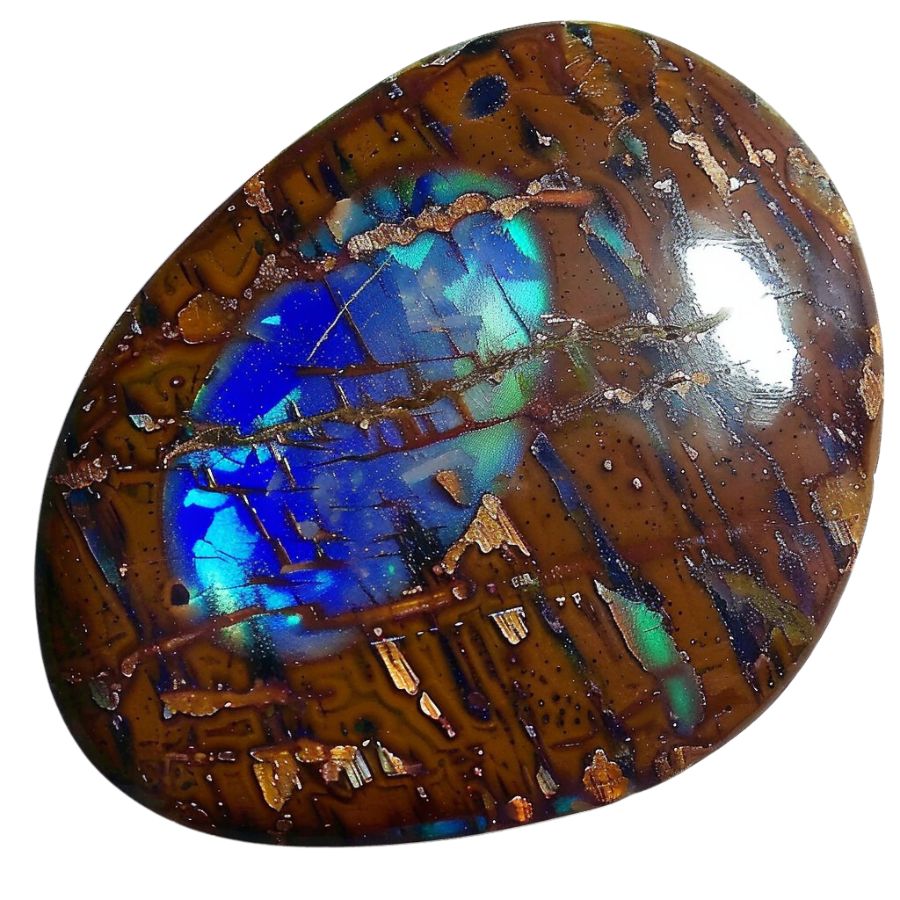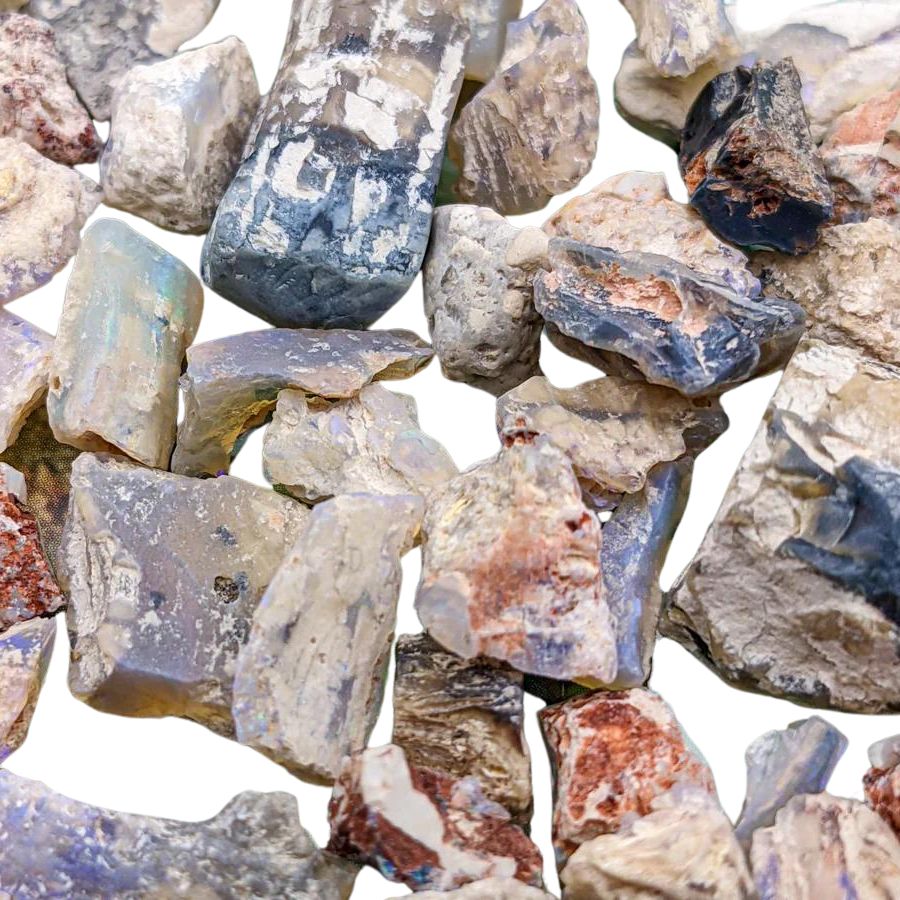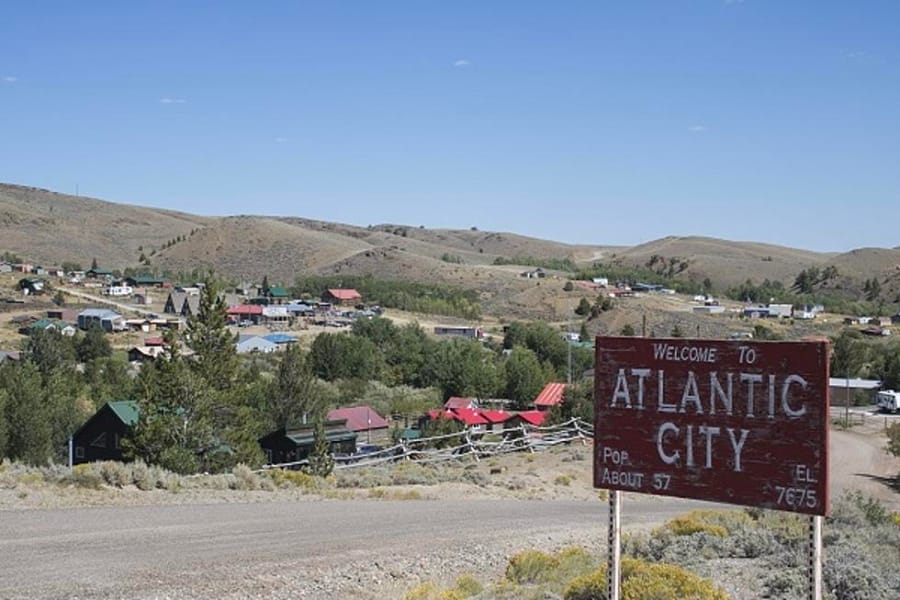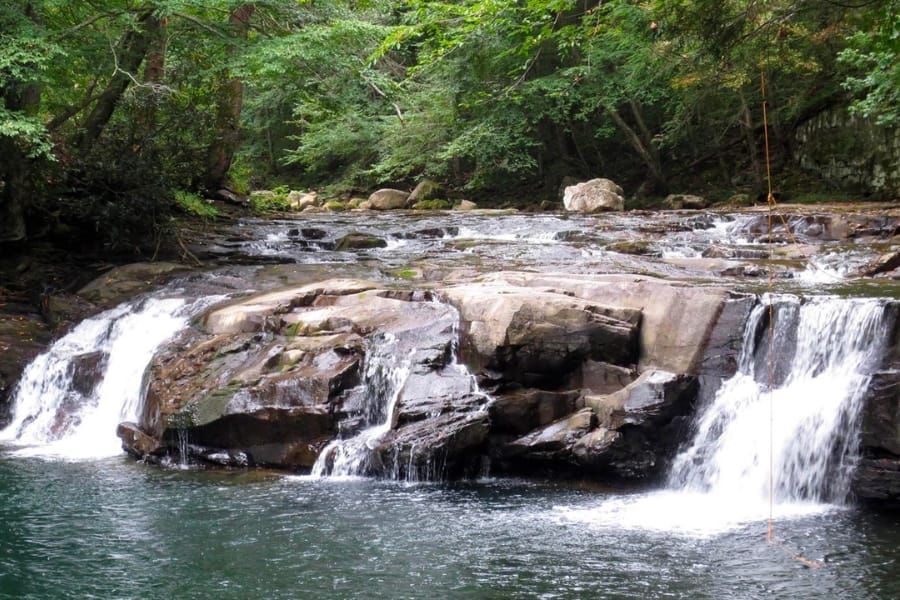If you’re looking to better understand where and how to find opal in Wyoming you’ve come to the right place. Opal is one of the most beautiful treasures you can find here but it can be tricky to locate.
The opal here comes in various types, including the fiery red fire type and the enchanting common one with its milky radiance. Whether tucked away in a remote mountain range or nestled in a dry riverbed, these gems demand a sense of adventure and determination to uncover.
If you’re eager to embark on an opal-hunting adventure, we’ll point you to the proven spots to find it such as the Atlantic City, Thorofare Wilderness, Crazy Woman Creek, Seven Mile Well, and Glade Creek.
The Types Of Opal Found In The US
There are several incredible types of Opal that can be found in the US as well as in our state. Each is uniquely beautiful and interesting including:

Common Opal
Common opal, also known as “potch,” stands out from other types of opal due to its lack of play-of-color, the iridescent display seen in precious opal. Instead, common opal features consistent, solid colors like white, pink, yellow, green, and blue.
It typically has a waxy to pearly luster and ranges from opaque to translucent. To identify common opal, look for its uniform color and absence of the shimmering color flashes found in precious opal.
Common opal forms under similar geological conditions as other opals, where silica-rich water seeps into rock cavities and slowly hardens over time. This process usually occurs in areas with volcanic activity or hot springs, where silica deposits are prevalent.

Fire Opal
Fire opal is known for its warm, vibrant colors, ranging from yellow and orange to deep red. Unlike precious opal, fire opal may or may not display the play-of-color, but its fiery body color makes it unique.
To identify fire opal, look for its bright, translucent to transparent appearance and the absence or presence of play-of-color within the warm hues.
Fire opal forms in volcanic regions where water rich in silica interacts with hot lava, filling cavities and fractures within the rock. Over time, the silica solution hardens, creating opal.
Visually, fire opal’s appeal lies in its vivid, flame-like colors that can be either uniform or exhibit internal flashes of color.

Boulder Opal
Boulder opal forms within the ironstone boulders of its host rock. Unlike other opals, boulder opal features precious opal veins intertwined with the natural rock, creating a beautiful contrast.
This opal is distinguished by its combination of colorful opal patches and the surrounding matrix, which can include ironstone or sandstone. To identify boulder opal, look for its vibrant play-of-color within the darker host rock, often showcasing brilliant blues, greens, and reds.
Boulder opal forms in sedimentary environments where silica-rich water infiltrates cracks and voids within ironstone or sandstone boulders. Over time, the silica hardens into opal, often creating thin seams or patches within the rock.

Hyalite Opal
Hyalite opal, also known as water opal, is a transparent to translucent type of opal that is distinctive for its glass-like appearance and lack of play-of-color. Unlike precious opal, which displays a rainbow-like iridescence.
You can identify hyalite opal by its clear to milky appearance, often with a slight green or blue fluorescence under UV light.
Hyalite opal forms in low-temperature hydrothermal environments, typically in volcanic regions. It precipitates from silica-rich fluids that fill cracks and voids in the host rock. This process can occur relatively quickly compared to other opal types.
Visually, hyalite opal resembles droplets of water or glass, often appearing as smooth, botryoidal (grape-like) formations. Its transparent nature makes it unique among opals, and its slight fluorescence adds to its allure.

Black Opal
Black opal is a rare and highly prized variety known for its dark body tone, which enhances the vibrant play-of-color. Unlike other opals, black opal has a deep background color, ranging from dark gray to jet black, making the iridescent colors more striking.
To identify black opal, look for its intense, dark base color coupled with brilliant flashes of blues, greens, reds, and other hues.
The presence of iron and carbon contributes to its dark body color. In the United States, black opal is primarily found in the Virgin Valley of Nevada, known for its rich opal deposits.

Crystal Opal
Crystal opal is known for its transparent to translucent body, which allows the play-of-color to shine through brilliantly. Unlike common opal, which is opaque, crystal opal’s clear or semi-clear nature enhances its vibrant internal colors.
To identify crystal opal, look for its see-through quality combined with flashes of color that can include blues, greens, reds, and more.
Its unique transparency sets crystal opal apart, making it a favorite among gem enthusiasts and collectors for its ethereal beauty.

Wood Opal (Opalized Wood)
Opalized wood is a fascinating form of petrified wood where the organic material has been replaced by opal. Unlike other opals, opalized wood retains the original structure and texture of the wood, creating a unique blend of organic and mineral elements.
To identify opalized wood, look for its wood grain patterns and opalescent sheen, often displaying a range of colors from white and brown to vibrant reds and greens.
Opalized wood forms under specific conditions where wood is buried in silica-rich sediment. Over millions of years, the silica solution gradually replaces the organic wood material with opal, preserving the wood’s original structure in stunning detail.

Contra Luz Opal
Contra Luz opal reveals its vibrant play-of-color when illuminated from behind. Unlike other opals, which display their colors through surface reflection, contra luz opal’s brilliance comes to life with transmitted light.
To identify contra luz opal, hold the gem against a light source and observe the internal flashes of color, which can include vivid reds, blues, greens, and purples.
This opal forms in volcanic environments where silica-rich water infiltrates cracks and cavities in the host rock. As the water evaporates, it leaves behind silica deposits that eventually solidify into opal.
Visually, contra luz opal appears nearly clear or milky when viewed without backlighting. However, when backlit, it displays stunning, colorful patterns that seem to glow from within.
What Rough Opal Looks Like
When you’re out looking for rough opal on your own it’s important to know what you’re looking for.
DON'T MISS OUT ON ANY GREAT FINDS!
While you're out searching for Geodes you're going to find a lot of other interesting rocks and minerals along the way. The last thing you want to do is toss out something really interesting or valuable. It can be easy to misidentify things without a little guidance.
We've put together a fantastic field guide that makes identifying 140 of the most interesting and valuable rocks and minerals you will find REALLY EASY. It's simple to use, really durable, and will allow you to identify just about any rock and mineral you come across. Make sure you bring it along on your hunt!
This is what you need to look out for:
Look for exteriors like this

Look for play-of-color
Opal can display a range of colors, but what sets precious opal apart is its play-of-color—vivid flashes of multiple colors that change with the angle of light. Even in rough form, you might see hints of these colors peeking through.
Common opal lacks this feature and typically appears as a solid color like white, blue, or pink.
Check for a glassy or waxy luster
Opal often has a distinctive glassy or waxy luster. When you find a potential opal, examine its surface.
It should look shiny and smooth, almost like glass, even if it is still encased in a matrix or rough exterior.
Assess the density and weight
Opal is generally lighter than rocks of a similar size. When you pick up a piece of rough opal, it should feel lighter than expected.
Additionally, opal is relatively soft, with a Mohs hardness of 5.5 to 6.5, so it can be scratched more easily than quartz or other harder minerals.
A Quick Request About Collecting
Always Confirm Access and Collection Rules!
Before heading out to any of the locations on our list you need to confirm access requirements and collection rules for both public and private locations directly with the location. We haven’t personally verified every location and the access requirements and collection rules often change without notice.
Many of the locations we mention will not allow collecting but are still great places for those who love to find beautiful rocks and minerals in the wild without keeping them. We also can’t guarantee you will find anything in these locations since they are constantly changing.
Always get updated information directly from the source ahead of time to ensure responsible rockhounding. If you want even more current options it’s always a good idea to contact local rock and mineral clubs and groups
Tips on where to look
Once you get to the places we have listed below there are some things you should keep in mind when you’re searching:
Search in Sedimentary Rock Formations

Opal can also form in sedimentary rock formations where silica deposits have accumulated over time.
Focus on areas with ancient lake beds or clay deposits, as these environments are conducive to opal formation.
Check Dry Creek Beds and Gullies

Dry creek beds and gullies can be excellent places to find opal, as water flow can erode and expose opal-bearing rocks.
Look for exposed rock and gravel in these areas, especially after rainfall or seasonal flooding.
Investigate Old Mining Sites

Abandoned or historical mining sites can be rich in opal and other minerals. These areas often have tailings and discarded rock that may still contain opal.
Always seek permission if the land is privately owned and follow safety guidelines.
Look for Indicator Minerals
Certain minerals can indicate the presence of opal. Look for rocks and soil containing ironstone, sandstone, or clay, as these materials often coexist with opal deposits.
Additionally, finding quartz or chalcedony can suggest nearby opal.
- The deep experience and understanding of our team about the area
- Recommendations from local groups and clubs
- How easy it is to get the a particular location
- Safety and potential hazards when collecting
- Weighing private and public locations
- The ability for both experienced and novice rock enthusiasts to find great samples
With these factors in mind we’ve been able to put together a fantastic list that just about anyone can use!
The Best Places To Find Opal

Wyoming has many great gem mine sites, but if you’re keeping your eye on the opal prize, below are the best places for you to explore. Here, you have the best chance of uncovering this gem.
Always Confirm Access and Collection Rules!
Before heading out to any of the locations on our list you need to confirm access requirements and collection rules for both public and private locations directly with the location. We haven’t personally verified every location and the access requirements and collection rules often change without notice.
Many of the locations we mention will not allow collecting but are still great places for those who love to find beautiful rocks and minerals in the wild without keeping them. We also can’t guarantee you will find anything in these locations since they are constantly changing.
Always get updated information directly from the source ahead of time to ensure responsible rockhounding. If you want even more current options it’s always a good idea to contact local rock and mineral clubs and groups
Atlantic City

Nestled in the Wind River Mountains, Atlantic City is a small, historic mining town that offers a picturesque setting with an exciting geological backdrop. It’s surrounded by vast, open landscapes with rolling hills and rocky outcrops.
The terrain here is quite diverse. You’ll find rugged mountains with steep slopes, as well as flatter areas with sagebrush and wildflowers. It also has a mix of sedimentary, metamorphic, and igneous rocks.
This variety makes it an interesting place for rockhounding, as different types of terrain can reveal different types of rocks and minerals.
If you’re eager to explore Atlantic City, you should know that it’s located about 30 miles south of Lander. You can drive there by taking Highway 28 to South Pass, then turning onto Atlantic City Road. This road leads directly into the heart of this town.
Always remember, though, to respect private property and follow local guidelines for collecting rocks and minerals. Review the local collecting guidelines of Wyoming before heading out here.
Where we found opal in the Atlantic City
You can explore the nearby streams, gravels, draws, washes, gullies, and hillsides in Atlantic City if you want to find opals.
DON'T MISS OUT ON ANY GREAT FINDS!
While you're out searching for Geodes you're going to find a lot of other interesting rocks and minerals along the way. The last thing you want to do is toss out something really interesting or valuable. It can be easy to misidentify things without a little guidance.
We've put together a fantastic field guide that makes identifying 140 of the most interesting and valuable rocks and minerals you will find REALLY EASY. It's simple to use, really durable, and will allow you to identify just about any rock and mineral you come across. Make sure you bring it along on your hunt!
Thorofare Wilderness

The Thorofare Wilderness is part of the larger Yellowstone ecosystem and is known for being one of the most remote areas in the lower 48 states. This means it’s a great spot for an adventure, but also that you should be prepared for a real wilderness experience.
It has rugged mountains, deep valleys, and vast forests. The area is dominated by the Absaroka Range, which is full of high peaks and steep slopes. The terrain here is challenging but rewarding, with trails winding through dense forests and across alpine meadows.
In terms of geology, the Thorofare Wilderness is fascinating. Its rocks tell a story of ancient volcanic activity and the powerful forces that shaped the Earth’s surface.
To get to the Thorofare Wilderness, you can start from Cody, then take the South Fork Road to the trailheads that lead into the wilderness. It’s important to remember that this is a remote area with limited access and no cell service, so plan accordingly.
Where we found opal in the Thorofare Wilderness
You can search through the area stream gravels of Thorofare Wilderness if you want to find opals and opalized wood.
Crazy Woman Creek

Crazy Woman Creek, with its unique name, flows through the scenic Bighorn Mountains, offering a picturesque landscape. The area around it is a mix of rugged mountains, rolling hills, and dense forests, creating a diverse terrain for exploration.
It’s notable for its steep canyons and lush valleys. The creek itself winds through various landscapes, providing a home to an array of wildlife. This area is not just beautiful; it’s also rich in geological history.
To get to Crazy Woman Creek, you can start from Buffalo. From there, take Highway 16 west towards the Bighorn Mountains. You’ll find several access points to the creek along this route.
Where we found opal at Crazy Woman Creek
To find opals at Crazy Woman Creek, we recommend searching through its stream beds, creek banks, gravel, and sand deposits.
Seven Mile Well

Seven Mile Well is part of the larger Yellowstone National Park, known for its breathtaking landscapes and unique geology. The Grand Canyon of Yellowstone, where it belongs, offers dramatic views with its deep, colorful canyon and the powerful Yellowstone River flowing through it.
The terrain around this spot is quite diverse. You’ll find steep canyon walls, lush forests, and open meadows. This variety in the landscape is not just beautiful to look at— it’s also great for exploring different types of rocks and minerals.
To get to Seven Mile Well, you’ll need to enter Yellowstone National Park. The nearest entrance to this area is the North Entrance near Gardiner, Montana. From there, you can drive along the Grand Loop Road towards the Grand Canyon of Yellowstone. The well is located near the Canyon Village area.
Where we found opal in the Seven Mile Well
You can explore and search through the different nooks and crannies of Seven Mile Well to find opals.
Glade Creek

Glade Creek is part of the beautiful Black Hills region. This area is known for its lush forests, rolling hills, and clear streams, making it a picturesque destination for outdoor adventures.
It offers a mix of dense woodlands and open meadows. The creek itself winds through various landscapes, providing a serene backdrop for your rock-hunting journey.
The terrain here is generally gentle, with some areas featuring steeper hills and rocky outcrops. It’s rich with a wide range of rocks and minerals, including opal.
To get to Glade Creek, you can start from the nearby town of Sundance. From there, take Highway 14 west towards the Black Hills. You’ll find several smaller roads and trails leading to Glade Creek.
Where we found opal in the Glade Creek
You can find opals in Glade Creek in areas where volcanic activity has occurred in the past. Checking near the creek beds, especially where water has eroded the surrounding rocks, can be a promising approach. The gravel bars along the creek are also potential opal-bearing spots.
Other Great Places To Find Opal

If you need more options, we’ve listed the other proven spots where you can find opals in Wyoming. They’re arranged by county for your convenient reference.
Our recommendations by county
| County | Location |
| Albany | Marshall area draws, washes, and surfaces |
| Carbon | Petrified forest area in Shirley Basin |
| Carbon | Saratoga regional draws, washes, surfaces |
| Carbon | Anderson Ranch |
| Crook | Bear Lodge alkaline complex |
| Fremont | Vitro Uranium Open Pit |
| Johnson | Crazy Woman Petrified Forest |
| Natrona | Angel Agates occurence |
| Park | Regional draws, canyons, soils in the Sunlight Basin District |
| Teton | Draws, flats, canyon gravels in the southwest side of the rugged Absaroka Range |
The laws about collecting opal
The legality of collecting opal in our state, like other rocks and minerals, largely depends on the location and land ownership.
On public lands, such as national forests and Bureau of Land Management (BLM) areas, recreational rock collecting is usually allowed, but there may be specific rules and limits on what and how much you can collect.
In state parks and national parks, such as Yellowstone, removing any natural materials, including opals, is typically prohibited to preserve the natural environment.
On private lands, you must obtain permission from the landowner before collecting any rocks or minerals. It’s crucial to research and understand the regulations of the specific area you plan to visit. For more information, consult with the Wyoming Bureau of Land Management (BLM).
The Best Places To Buy Opal

Another way you can see and take home Wyoming opals is to visit our local rocks and minerals shop. Below are some of our favorites:
- Antares Minerals & Pottery – 431 Front St, Evanston, WY 82930
- Avas Silver & Rock Shop – 631 Shoshoni St, Thermopolis, WY 82443
- Star Valley Rock Shop – 300 Stockhorn, Thayne, WY 83127
- Stone Age Industries – 654 Ln 5, Powell, WY 82435
- Torrington Rock Shop – 4102 US-26 #85, Torrington, WY 82240
- Twinkle Twinkle Little Store – 3344 Ridge Rd #7, Cheyenne, WY 82001


